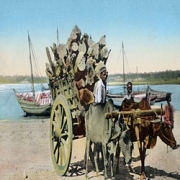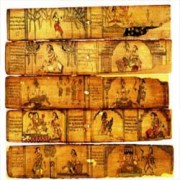Ancient India Economy

The Indus civilization's economyThe glimpses of the ancient Indian economy can be ascertained from the Indus valley civilization and the Gangetic civilization developed during the Vedic times. While excavation from the various Indus sites gives us the glimpse of the urban economy flourishing at that time, the monuments of the Vedic times and its written records makes us construct the picture of the economy of that time.
Ancient India Economy in Indus Valley Civilization
Since Indus valley civilization was of Bronze Age and its economy was more urban based whereas the Vedic civilization is marked by Iron Age its economy was related more to the agricultural mode of production.
Archaeologists have discovered a massive, dredged canal and docking facility at the coastal city of Lothal, signifying the importance of overseas trade during the Indus valley civilization. The Indus civilization's economy appears to have depended significantly on trade, which was facilitated by major advances in transport technology.
The terracotta figurines of boats and bullock driven cartssuggest their use in propagating the Indus valley economy. Many of the figurines of the boats are small, flat-bottomed craft, perhaps driven by sail. There is also some evidence of large sea-going craft. The figure of bullock-driven cart points to its use in the inland tradeas a mode of transportation.
The dispersal of the artefacts of the Indus civilization suggest the trade networks, economically, integrated a huge area, including portions of Afghanistan, the coastal regions of Persia, northern and central India, and Mesopotamia.
The people of Indus valley civilization traded with Sumer and Sumerian merchants referred them as Meluhha. They also traded with Mesopotamia and Egypt. They sent merchant ships to the island of Tilmun in the Persian Gulf.

Bullock-driven carts The main items of exports included surplus grain, pottery vases, inlays, ivory combs, pearls, precious woods, and semi-precious stones. Indus Valley farmers grew wheat, barley, field-peas, melons, sesame, and dates. They also domesticated humped cattle, short-horn cattle, and buffaloes, and perhaps even pigs, camels, horses, and donkeys. The land was full of water buffalo, tigers, elephants, rhinoceros and enormous forests.
Cotton was first developed around 2000 B.C. and Indus valley people were the first to turn cotton into yarn and weaving the yarn into cloth. The lack of public inscriptions or written historical documents has hindered more information about the economy of the Indus valley civilization. The unique Indus script consisting of 400 symbolic pictures is not yet deciphered.
Ancient India Economy in Vedic Age
The Aryans entered the northern part of India from Central Asia by 1500 BC. The Aryans re kindled the light of a new economy on the banks of the river Ganges. The Aryan society was characterized by a nomadic lifestyle and cattle rearing being the chief occupation. Cattle and cows were held in high esteem and frequently appear in Rigvedic hymns; goddesses were often compared to cows, and gods to bulls.
Aryans had learned to use iron by 1,000 BC and as the community settled down, Agriculturegained prominence. In the course of time Aryans went on to became farmers.They learned to farm rice cultivationby 600 BC. It’s because of farming activity a more ordered and settled society evolved.
Society was strictly organized on caste system and the economic structure stood of the division of labour of the caste. While the Aryans became the priests, rulers, warriors, peasants and merchants, the lower rank was left for the natives called as Shudra. The occupations were based on four major varnas, Brahmin, Kshatriya, Vaishya and Shudra.
The food of the Rigvedic Aryans consisted of parched grain and cakes, milk and milk products, and various fruits and vegetables.

Families were patrilineal Consumption of meat was also common among, at least among the upper classes. The Rigveda contains many references to animal sacrifice and meat offered to the gods.
The people in the Vedic period lived in straw and wooden huts. Some homes during the epics period were made of wood.They also introduced horse and chariot races.The social life cantered on Yagna meaning s a ritual of sacrifice.
Money was unknown, and bartering with cattle and other valuables was the favoured way of conducting trade and commerce.
With a more settled and ordered society trade and commerce started to flourish. Life in towns evolved again and writing was re-invented. By 600 BC a highly civilized society had emerged in India with its economy based on rural mode of production and its surplus being exported through trade and commercial activities.
Contribute More Facts